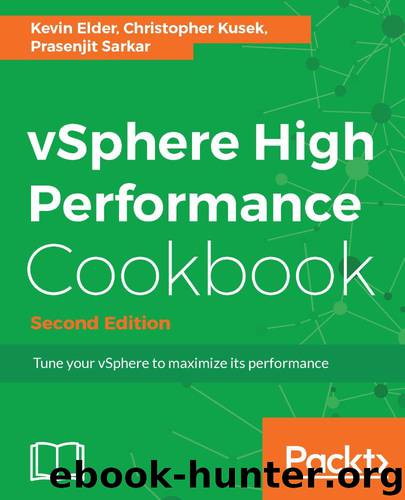vSphere High Performance Cookbook - Second Edition by Kevin Elder & Christopher Kusek & Prasenjit Sarkar

Author:Kevin Elder & Christopher Kusek & Prasenjit Sarkar [Elder, Kevin]
Language: eng
Format: azw3
Publisher: Packt Publishing
Published: 2017-06-30T04:00:00+00:00
Now you are ready to create a scale-up cluster that has fewer hosts with rich configurations/capacity for your server workload.
To create a scale-up cluster, repeat the previous steps except:
In step 4, name the cluster scale-up.
Choose the scale-up hosts in step 10 and add subsequent hosts there.
How it works…
Scale-up and scale-out clusters have their advantages and disadvantages.
The primary advantage of a scale-up cluster is that it takes less effort to manage and monitor; thus, it is less expensive (in terms of operational cost). When it comes to the other infrastructure components, such as power, cooling, and space, this cluster is also beneficial as it might consume less than a scale-out cluster. If you choose to virtualize user desktops, then a scale-up cluster is preferable.
However, a scale-up cluster has disadvantages as well. Consider a failure domain of a scale-up cluster. A single host failure in a scale-up cluster can affect many VMs at the same time. vSphere HA will need to restart those failed VMs. Also, the reservation of failover capacity is also huge, as reserving a single host also impacts cluster resource reservation.
DRS migration options are very limited in a scale-up cluster. This may result in workloads that are not balanced perfectly between all the hosts.
You may need to consider the HA maximum VM limit as well. In a scale-up cluster, you may end up reaching that limit very fast (8,000 VMs per cluster in vSphere 6.5); then HA will not be able to restart those VMs after a failure.
Similarly, a scale-out cluster also has several advantages and disadvantages. As opposed to the scale-up cluster, only fewer VMs are affected in a scale-out cluster due to a single host failure, and the failover takes effect quickly as well. Also, fewer resources will be reserved for the failover.
With DRS enabled, a scale-out cluster has the option to provide more choices to VMs, in terms of migration and load balancing. Also, it is hard to reach the per-host VM limits in a scale-out cluster.
However, it can consume more power, cooling, and floor space. For example, four-socket servers take 2U-4U of space in the rack, whereas two-socket servers take 1U-2U of space in the rack. Additional cost could be related to the network port. Operational complexity and costs are also high in the case of a scale-out cluster.
Download
This site does not store any files on its server. We only index and link to content provided by other sites. Please contact the content providers to delete copyright contents if any and email us, we'll remove relevant links or contents immediately.
Test-Driven iOS Development with Swift 4 by Dominik Hauser(10394)
Filmora Efficient Editing by Alexander Zacharias(6711)
The Infinite Retina by Robert Scoble Irena Cronin(6218)
Learn Wireshark - Fundamentals of Wireshark. by Lisa Bock(4483)
Linux Device Driver Development Cookbook by Rodolfo Giometti(4052)
Edit Like a Pro with iMovie by Regit(3918)
Linux Administration Best Practices by Scott Alan Miller(2963)
Linux Command Line and Shell Scripting Techniques by Vedran Dakic & Jasmin Redzepagic(2914)
Mastering PowerShell Scripting - Fourth Edition by Chris Dent(2874)
Creative Projects for Rust Programmers by Carlo Milanesi(2712)
MCSA Windows Server 2016 Study Guide: Exam 70-740 by William Panek(2603)
Docker on Windows by Stoneman Elton(2393)
Kali Linux - An Ethical Hacker's Cookbook: End-to-end penetration testing solutions by Sharma Himanshu(2373)
Hands-On AWS Penetration Testing with Kali Linux by Karl Gilbert(2215)
Hands-On Linux for Architects by Denis Salamanca(2151)
Programming in C (4th Edition) (Developer's Library) by Stephen G. Kochan(2130)
Computers For Seniors For Dummies by Nancy C. Muir(2127)
The Old New Thing by Raymond Chen(2079)
Linux Kernel Debugging by Kaiwan N Billimoria(1837)
